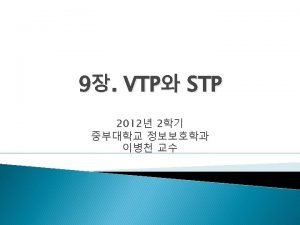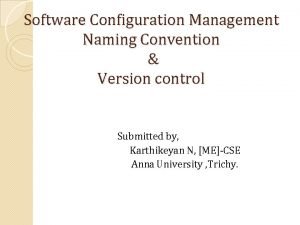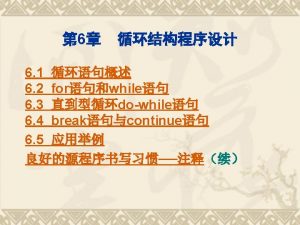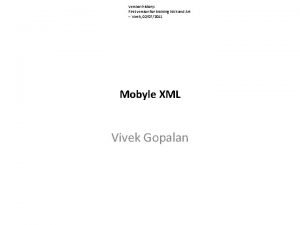KXTDE 100200 System Version 1 0 Chapter 7




















- Slides: 20

KX-TDE 100/200 System (Version 1. 0) Chapter 7 VIPGW Panasonic Communications Co. , Ltd. Office Network Company Edition 1. 3 4 th July, 2007 Confidential 1

Chapter 7 VIPGW 1. VIPGW/IPGW 2. VIPGW Installation 3. VIPGW Settings Example 4. Called Port Distribution Groups 5. PCMC Settings 6. GK Settings Confidential 2

1. VIPGW/IPGW 1. Difference between IPGW 16 and VIPGW 16 Although the functionality of the VIPGW 16 on the IPCMPR is almost the same as the IP-GW 4/16 you will still need to use web programming for the IP-GW 4/16 card. However, for the V-IPGW 16 card on the IPCMR card, you can program using the TDE 100/200 PCMC (Web programming for TDE/V-IPGW will be available from v 2). The main functional differences are as follows… (1) CODEC G 711, G 723 and G 729 are supported on IP-GW 4/16. G 711 and G 729 are supported on VIPGW 16. (2) CODEC Parameters IP-GW 4/16 cards are each configured individually. VIPGW 16 cards are configured by destination PBX. CODEC: G 711 VAD: Enable IP-GW 4/16 CODEC: G 729 VAD: Disable CODEC: G 711 CODEC: G 729 VAD: Enable VAD: Disable Confidential VIPGW 16 3

2. VIPGW Installation (1/2) First, install the V-IPGW 16 card in the virtual shelf using the PCMC tool. Once this card is installed you must then click on ‘Activation Key’ and allocate the required number of KXNCS 4104 license to H 323 trunks. If a license is not allocated in this way, the TDE will assume the license is to be used for SIP trunks. Failure to allocate an H 323 trunk license will result in the V-IPGW 16 card showing status ‘INS’ but all ports will show status ‘OUS’ PCMC Menu item 1 -1 MPR Virtual Slot. Select Shelf – Activation Key Confidential Any attempt to change the status will result in a ‘Card Obstacle’ error until a license is allocated correctly 4

2. VIPGW Installation (2/2) 1 Confirm the required number of ports show status ‘INS’ (If showing OUS after licensing please check previous steps required for correct licensing) In the example given, there is 1 x KX-NCS 4104 license installed (Each port counts for 2 trunks = 2 ports = 4 trunks = 1 x KXNCS 4104). PCMC Menu item 1 -1 -MPR Virtual Slot-Select Shelf – V-IPGW 16 Card – Port Property All other PBX programming points are identical to TDA series (CO Line Settings, System Numbering Plan, TIE Table) Confidential 2 5

3. VIPGW Settings Example (1/2) Outgoing Setting PBX-A 31 xx Dial - 31 xx IPCMPR: 10. 60. 45. 10, GW No=1 10 xx IPCMPR: 10. 50. 45. 10 PBX-0 Dial - 32 xx PBX-B 31 xx IPCMPR : 10. 70. 45. 10, GW No=2 32 xx Dial - 200 xxx By using the GW Group function, the TDE can make a call to next available GW if all ports are in use on the current GW If You dial 200 xxx, and all IPCMPR trunks are busy, PBX-0 will automatically make a call to IP-GW 16 -1 instead (using GW groups). Error Dial - 200 xxx PBX-C 200 xxx Confidential IPCMPR : 10. 80. 45. 10, GW Group No. =10 IP-GW 16 -1 : 10. 80. 45. 11, GW Group No. =10 IP-GW 16 -2 : 10. 80. 45. 12, GW Group No. =10 6

3. VIPGW Settings Example (2/2) Outgoing Setting Note: T 38 protocol is not supported. GW Settings Table GW No. GW Name GW-IP Address GW Group 1 st CODEC Priority P sampling Time(G 711) Progress Tone 1 PBX-A(IPCMPR) 10. 60. 45. 10 0 G 729 A 20 msec Internal 2 PBX-B(IPCMPR) 10. 70. 45. 10 0 G 729 A 20 msec External 3 PBX-C(IPCMPR) 10. 80. 45. 10 10 G 729 A 20 msec Internal 4 PBX-C(IP-GW 16 -1) 10. 80. 45. 11 10 G 729 A 20 msec Internal 5 PBX-C(IP-GW 16 -2) 10. 80. 45. 12 10 G 729 A 20 msec Internal New “ 0” means No GW Group No. : 512 Parameter Setting for every GW 0 DN 2 IP Table Index No. Leading Number Remaining Number of Digits GW No/GW Group Selection GW Group No. GW No. 1 31 2 GW No 0 1 2 32 2 GW No 0 2 3 200 3 GW Group 10 3 2 GW No 0 1 --512 10 Confidential 7

4. Called Port Distribution Groups TDE Side CO-001 CO-002 CO-003 CO-004 CO-005 CO-006 CO-007 CO-008 CO-009 CO-010 CO-011 CO-012 CO-013 CO-014 CO-015 CO-016 CO-017 CO-018 : : CO-031 CO-032 Confidential Port 1 -ch. 1 Port 1 -ch. 2 Port 2 -ch. 1 Port 2 -ch. 2 Port 3 -ch. 1 Port 3 -ch. 2 Port 4 -ch. 1 Port 4 -ch. 2 Port 5 -ch. 1 Port 5 -ch. 2 Port 6 -ch. 1 Port 6 -ch. 2 Port 7 -ch. 1 Port 7 -ch. 2 Port 8 -ch. 1 Port 8 -ch. 2 Port 1 -ch. 1 Port 1 -ch. 2 VIPGW 16 -1 Index 1 2. . 6 7 8 9. . 16 Destination Digits=30 xx CDPG=3, 4. . . Slot 1 Prt 7 Slot 1 Prt 8 Slot 2 Prt 1 CO-013 CO-014 CO-015 CO-016… : VIPGW 16 -2 : Port 8 -ch. 1 Port 8 -ch. 2 CDPG Table Incoming Call V-slot 1 1. . 1 1 1 2. . 2 Port 1 2. . 6 7 8 1. . 8 Conn. INS INS. . OUS New CDPG 1 1. . 2 3 4 4. . 16 Incoming call Hunt Pattern Table Index Leading Digit 1 2 3. . 32 10 20 30. . 400 CDPG Priority 1 1 1 3. . 8 CDPG Priority 2 2 2 4. . 16 CDPG Priority 16 16. . 8

5. PCMC Programming (1/8) Gatekeeper Available = Enable/Disable Call Signal Model = Direct/Routed GK Check Interval = 0 (0 -1440 Minutes) Pri/Sec Gatekeeper = IP and port number H 225/RAS/QSIG = Port configurations RTCP Options = Used for performance analysis RTP Qo. S Type = TOS/DSCP/HEX Echo Canceller = 48 ms/128 ms/off Gain adjustment = EC or DSP NLP Setting = EC distortion/quality issue adjustment QSIG CT/CF = QSIG Call Transfer, forward function QSIG Network Type = Private/Public/VPN Confidential 9

5. PCMC Programming (2/8) All V-IPGW 16 settings can be found under ‘Shelf Property’ in the PCMC. This where all other GW endpoints, DN 2 IP settings and incoming hunt patterns are set. (These settings would normally be programmed through a web interface on the KXTDA 3480/0484/0490 cards) PCMC Menu item 1 -1 -MPR Virtual Slot-Select Shelf – V-IPGW 16 Card – Shelf Property Confidential 10

5. PCMC Programming (3/8) PCMC Menu item 1 -1 -MPR Virtual Slot - Select Shelf – VIPGW 16 Card – Shelf Property – GW Settings REQUIRED SETTINGS GW Name = 20 ASCII character label GW IP Address = IP Address (Not DNS name) GW Group = GW Group (For DN 2 IP function) Connection For IP-GW 16 = Select whether the remote gateway is a V-IPGW 16 (TDE) or IPGW (3480/0484/0490 card) Confidential 11

5. PCMC Programming (4/8) PCMC Menu item 1 -1 -MPR Virtual Slot - Select Shelf – VIPGW 16 Card – Shelf Property – GW Settings OPTIONAL SETTINGS IP Codec Priority = G 729 a/G 711 a-law/G 711 mu-law (Default is G 729 a) Packet Sampling Time = 10 ms-60 ms (Default 20 ms – Increments of 10 ms) *G 722 is only supported on IPPT (NT 300) V-IPGW 16 supports G 711 and G 729 a only Confidential 12

5. PCMC Programming (5/8) PCMC Menu item 1 -1 -MPR Virtual Slot - Select Shelf – VIPGW 16 Card – Shelf Property – GW Settings OPTIONAL SETTINGS Voice Activity Detection = Enable/Disable sending of packets during silence (Default = Disable) Fax Detection Ability = Enable/Disable automatic detection of faxed data (Default = Disable) DTMF Type = Inband/Outband (H 225)/Outband (RFC 2833) (Default = Inband) DTMF Payload Type Confidential = Value, 96 -127 (Default 101) 13

5. PCMC Programming (6/8) PCMC Menu item 1 -1 -MPR Virtual Slot - Select Shelf – VIPGW 16 Card – Shelf Property – DN 2 IP REQUIRED SETTINGS Leading Number = Up to 30 digits, specifies call routing based on dialed number Remaining Number Of Digits = Specifies how many following digits should be expected after the leading number (Max 29 digits) GW No. /GW Group Selection = Route call to either individual GW or to GW Group = Specifies which GW Group the entry belongs to GW No. = Specifies an individual GW entry to route calls to Confidential 14

5. PCMC Programming (7/8) PCMC Menu item 1 -1 -MPR Virtual Slot - Select Shelf – VIPGW 16 Card – Shelf Property – Hunt Pattern REQUIRED SETTINGS Leading Number = Leading number of incoming call (30 digits max) Call Distribution Port Group = Specifies the required port distribution group Confidential 15

5. PCMC Programming (8/8) PCMC Menu item 1 -1 -MPR Virtual Slot - Select Shelf – VIPGW 16 Card – Port Property Ports may be allocated to specific call distribution port groups in order to manage incoming calls (By default all ports exist in CDPG 1). This feature is currently only configurable for V-IPGW cards. There are no options to add IPGW 4/16 cards to the same CDPG configuration. Confidential 16

6. GK Settings - GK Registration (1/3) When IPGW / VIPGW use a Gatekeeper, IPGW / VIPGW have to register the IP Address and leading number for the PBX Gatekeeper Register IP address(192. 168. 0. 10) Leading Number( 911, 912, 913, 914) IPGW (192. 168. 0. 10) - 911 xxxx - 912 xxxx - 913 xxx - 914 xxx IPGW (192. 168. 0. 20) - 915 xxxx Confidential Register IP address(192. 168. 0. 20) Leading Number( 915) VIPGW (192. 168. 0. 101) Leading Number 911 912 913 914 915 916 917 918 919 920 : IP Address 192. 168. 0. 10 192. 168. 0. 20 192. 168. 0. 101 : Register IP address(192. 168. 0. 101) Leading Number( 916, 917, 918, 919, 920) -916 xxxx -917 xxxx -918 xxx -919 xxx -920 xxx 17

6. GK Settings - IP-GW (2/3) (1) In case of IP-GW (TDA) The combination of GW entry table and DN 2 IP table informs the IP address and leading number information to the Gatekeeper Use Don’t use GW Entry Table GW No. 0 1 DN 2 IP Table Comments 2 : 511 : IP Address 192. 168. 0. 10 Own IPGW IP address : Group No. 0 0 0 : 0 Index 0 1 2 3 4 : 512 Leading Number 911 912 913 914 Remain digits GW No. / Group No. GW No. GW Group No. 0 0 Own IPGW leading digits Information of IP address (192. 168. 0. 10) & leading number (911, 912, 913, 914) Are now registered with the Gatekeeper. Confidential 18

6. GK Settings – VIPGW (3/3) (2) In case of VIPGW (TDE) Gatekeeper settings table informs this information to the Gatekeeper Available : Enable PCMC : Shelf Property – Virtual IP Gateway GK Settings Table Index 1 2 3 4 5 : 32 Destination Number 916 917 918 919 920 Leading Number Device Name Group -1 Group -2 Group -3 Group -4 Group -5 PCMC : GK Settings Own IPGW leading digits For reference The IPCMPR IP address(192. 168. 0. 101) & leading number information (916, 917, 918, 919, 920) are now registered with the Gatekeeper. Confidential 19

Chapter 7 VIPGW Thank you very much ! Confidential 20
 Urs v2
Urs v2 Climate forecast system version 2
Climate forecast system version 2 Concurrent versioning system
Concurrent versioning system Climate forecast system version 2
Climate forecast system version 2 Versionhallinta git
Versionhallinta git Numeracy continuum acara
Numeracy continuum acara Vtp version 3
Vtp version 3 Version control systems industry
Version control systems industry Uft version history
Uft version history Triangle congruence (a) maze
Triangle congruence (a) maze Heb 4:12 amp
Heb 4:12 amp Apostles creed prayer
Apostles creed prayer Subversion tutorial
Subversion tutorial Risk student version
Risk student version Software numbering conventions
Software numbering conventions Que es sac
Que es sac Romeo and juliet prologue summary
Romeo and juliet prologue summary Alan rea
Alan rea Little red riding hood a revised version answers
Little red riding hood a revised version answers El autor secundario de la biblia es
El autor secundario de la biblia es Nhdplus version 2
Nhdplus version 2







































